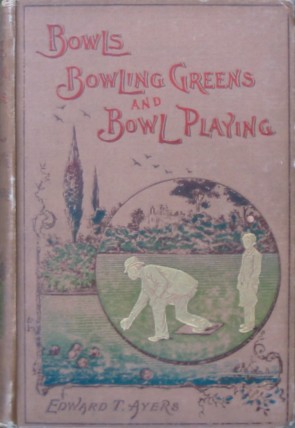| Title | Bowls, Bowling Greens, and Bowl Playing | ||
| Author | Edward T Ayers | ||
| Publisher | Jarrold & Sons, London | ||
| First published | 1894 | ||
| ISBN | Pre-ISBN system | ||
| Edition reviewed | 2nd (revised and enlarged; year of publication not stated) | ||
| Hardback/softback | Hardback | ||
| List price | Not known | ||
| Cover size (cm) (height x width) |
19.0 x 12.4 | ||
| Number of pages | 144 (including advertisements) | ||
| Number of pages with | Coloured photos | Black & white photos | Line drawings |
| None | 3 | None | |
| Synopsis | Although this book is clearly of greatest interest to bowls historians, few bowlers would fail to find something of fascination in its 144 pages - for example, the account of the measuring of close bowls by means of a reed that was carefully shortened: . . . so that one end rested on the jack and the other on the bowl to be measured, extreme care being taken lest the reed should be the merest trifle too long. Sometimes the reed is too much shortened and the elaborate work has to be done over again; a trifling bet occasionally increasing the excitement.
And the following description of some of the geographical differences in the way that bowls was played in the 1890s hints at the way the game was ultimately to develop with different codes. Of particular interest is the fact that the author played his bowls in Norfolk and Suffolk. To my mind, the dead level they [the Scots] appear to aim at in laying out their greens by the aid of the spirit-level tends to sameness (not to say tameness) of play. Inequalities in the surface, if not too great, are distinctly interesting, and an improvement, and mostly so, when originally unintentional. Moreover, the Scotch divide their greens into 'rinks', or sections, about 20 feet wide, one of which is allotted to each set of players, whose play is confined, up and down, on that particular spot. In the northern counties of England the game is played much in the same way as in Scotland, but the midland and southern English usually play 'all over the shop'; the various sets may cross each other in play, and though collisions now and then occur, ample compensation is supplied in the perpetual changes of ground necessitating corresponding varieties of play, and the expressions of annoyance or glee of the players, when an advancing bowl collides with one of another set, or the foot of a crossing player, can be better imagined than described.
The book is full of such engrossing curiosities - the delightful style of the period heightening the reader's enjoyment. Also by Edward T Ayers: |
||



